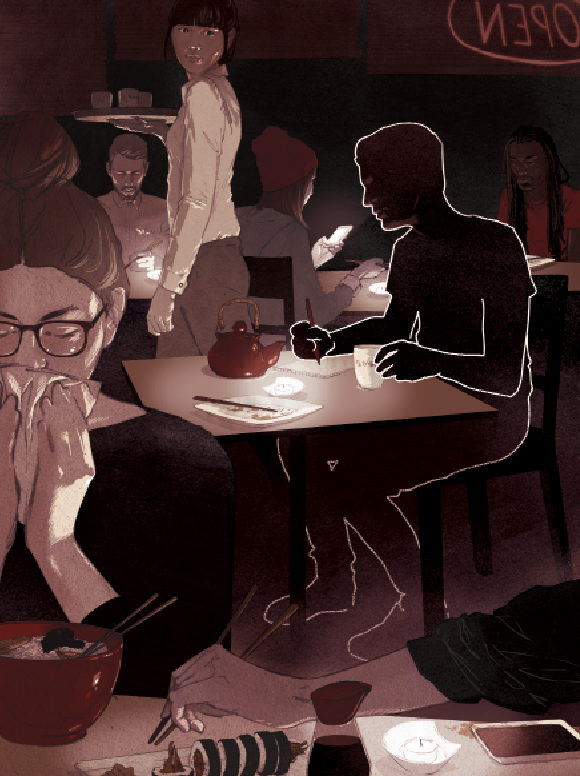Feeding frenzy
How a new generation of food writers is taking a bite out of the high-dining critics and Yelp-loving bloggers to change the flavour of restaurant reviewing.
Sitting at a table in Bua Thai, a small, dimly lit restaurant nestled in among a run-down pharmacy, a breakfast place with a broken sign, and a nearly empty grocery store on The Queensway in Toronto, Andrew Widla, 27, recently had what he calls some of the best pad thai in the city. And yet it was not in the pages of Toronto Life or The Globe and Mail he read about Bua Thai. Craving rice noodles, bean sprouts, and peanuts, Widla took to a Toronto culture blog, blogTO, where he found himself reading about the Bua Thai dish, which was said to have “a thinner rice noodle, more egg, and a tamarind-tomato combo punch.” Widla took a chance on the small restaurant and has come back again for the flavourful dish.
“I don’t put a lot of faith in the reviews in newspapers or magazines done by renowned restaurant critics,” Widla says. “I prefer an unfiltered, candid, and far more realistic approach to restaurant reviewing from your average person.”
It may seem as though restaurant critics have gone the way of white tablecloths and cheese soufflés, replaced by hordes of shawarma scarfers and chicken-wing gobblers on Yelp. But it turns out that younger diners have as much of an appetite for restaurant writing as ever before, only instead of lengthy features on fancy French restaurants, many diners are eating up shorter stories about unassuming but authentic ethnic restaurants and boisterous chefs. As Jacob Rutka, the 29-year-old assistant editor and writer at The Grid, says, “A lot of people might want to revolt against this stodgy food writing that you see in newspapers and magazines.”
For years, restaurant critics like Joanne Kates of the Globe and James Chatto of Toronto Life were feared by chefs and worshipped by diners. Tables were booked and dishes were ordered based on what they wrote. Given comfortable budgets and rich word counts, these writers seldom spared a detail when it came to the culinary direction of a menu, the artistic plating of an amuse-bouche, or the gastronomic harmony of a bouillabaisse.
In 2009, a year before he left Toronto Life, Chatto recalled a dinner he had at Bite Me!, the now-defunct, unabashedly upscale French restaurant of chef Marc Thuet and his wife, Biana Zorich. “When I was last there,” he wrote, “I succumbed to the $160 ‘menu chasseur et truffes blanches.’ It was a meal of extraordinary delights, above all a Perthshire partridge consommé perfumed by slivers of white truffle and enriched with a raw quail egg. Then there were the gnocchi—little clouds that proved to be the shameless excuse for a ragoût of wild pigeon breast, the purple meat so tender and rare, pillowed with sautéed foie gras and more white truffle, slippery golden chanterelles from B.C., a game jus reduced almost to the texture of syrup and a dab of plum and vanilla sauce to freshen the labouring palate.”
But in the past couple of years, the way that restaurants are being written about has begun to change. Restaurant criticism has gone from Kates rejoicing over “lashings of truffle oil” at Modus Ristorante and “fresh green fava beans over gossamer ravioli stuffed with Dungeness crab in delicate shellfish broth” at Scaramouche to her successor, Chris Nuttall-Smith, scooping up “hella sexy” baba ghanouj at Dr. Laffa, an Israeli-Iraqi restaurant in a North York strip mall. Older gourmets may be lamenting the change in restaurant criticism, but many younger diners view the change as the start of a more street-level approach to food writing.
“We are seeing a rise of food criticism, in a certain sense,” says Rutka, who often writes about food for The Grid. With the alt-weekly for about two years, he’s focused more on food for the past year, just as the paper began to stir up its food section. “I started working more with Karon [Liu, the other food writer],” he says, “and we launched the food blog and tried to do things that were a bit more unique than just simple food reviews, which we don’t do.”
Rutka, like many younger food writers, insists that he is not a restaurant critic in the manner of Kates and Chatto, but much of his writing does seem to resemble a sort of restaurant criticism. He recently wrote about JaBistro, a Japanese restaurant, and, though he describes the deep-fried prawns, the miso and sweet chili dressing, and the way chef Koji Tashiro stirs his rice, Rutka mostly keeps his mouth shut when it comes to the dishes. His description of the thin slices of amberjack, a mild white fish, dressed with lemon and sea salt, is mouth-watering, but he leaves it up to his readers to taste the fish for themselves instead of telling them what to think.
When they do want to be told what to think about the flavours in a bowl of biryani or the ingenuity of a sushi spread, some would rather read about it from another diner like them. “Traditional, old-school critics bring a lot of knowledge and experience to the table, but, at the same time, some of them give off a pretentious vibe that is difficult to understand and relate to,” says Erika David, a 26-year-old food blogger from Montreal.
In late fall, David went to Nudo, a Chinese noodle restaurant, and wrote, “I don’t care that it looks like a gloomy banquet hall or that the weirdest Chinese movies always seem to be playing. Eating these noodles morning, noon and night is my only wish this Christmas.” She continued: “Order the pickled mustard tuber and pork noodle soup with chicken broth. I’m not being bossy—I’m simply doing you a favour.” And when she went to Ramen-Ya a month before, she told her readers, “I wouldn’t dare string the words authentic, ramen and Montreal in one sentence to gush about anything we’ve got going on here, right now. But that doesn’t mean that there aren’t places in the city where I can lick a bowl of ramen dry and like it.” She went on to write about the roast pork and spicy miso broth, saying, “Floating at the surface are thin slices of succulent pork with hints of sweetness and layers of fat accompanied by wakame, wood ear mushrooms, bean sprouts, spring onions and sesame seeds. Get it. I didn’t regret it.”
David is thorough, detailed, and knowledgeable when she writes about the flavour and authenticity of dishes, but her voice is also bursting with attitude, candour, and sometimes, an unhinged sense of humour. When writing about the cramped communal tables at Maïs, a small taco shop, she recommends claustrophobic diners take their medication.
Believing that “humour, personality, and writing with a relatable quality are also important—no one on this planet can get through stiff, dry material,” David may be serious about her noodles and chicken broth, but she is laid-back when it comes to her writing.
Although he may not have the same sass, Sherman Chan, 40, from Vancouver, is another blogger who has become known for having an honest, adventurous, and dryly witty writing style. Chan recently went to Western Lake, a seafood spot in Vancouver, and noted that the spring rolls were “crispy and light” and “jammed-packed with whole crunchy shrimp.” The chicken feet, he reported, were nearly flawless. “The halved feet were plump and fatty with a nicely fried exterior. The skin was intact and not shriveled with a good amount of soft tendon underneath. Once again, the sauce was sweet, with a good hit of garlic.” But he also added, in his signature snarky tone, that finding above average dim sum in the Vancouver area is about as easy as “running into a poorly parked car in Richmond” and complained about having to bring his mother-in-law to dinner—he often writes about the many friends and family he eats with and the situations that unfold around each meal. “I think people want to hear about real life experiences that are honest and raw,” Chan says.
Not long ago, honest, raw restaurant reviews were only found on blogs, but now even the Globe has taken on Toronto’s rowdy chefs and the small, unassuming ethnic spots that are opening in the suburbs. One month after Kates retired as the restaurant critic at the Globe, Chris Nuttall-Smith wrote a story about the 10 best places to eat in Scarborough, the distant east end of Toronto, which gave readers a taste of the kind of restaurant writing that he would be serving up more of. His prose packed quite a bit of heat. He wrote about the “inky, smoky chili sauce” of Shawarma Empire, the “entrancingly sweet-mellow eggplant” of Nantha, the “constant drum of griddle cooks chopping curry, egg, onions and day-old flatbread” at Babu.
There are plenty of reasons for the changing tastes in restaurant criticism, but it is undeniable that Yelp has also changed the way people learn about restaurants. Yelp, of course, is the online restaurant guide that allows diners, discerning or not, to write about the restaurants where they have eaten and to award them one to five stars. Many Yelpers eat out as if they were restaurant critics themselves, often taking notes and snapping pictures with their phones. They are known for lining up at restaurant openings, tweeting furiously on the night of, and writing about their meal on Yelp the morning after. Yelp is a mélange of unjustified rants, undeserved praise, raves from friends of the owners, pans from disgruntled former waiters—and, every now and then, insightful criticism from truly informed diners.
“There are definitely discerning diners who have palates every bit as talented as a restaurant critic, but how do you differentiate them from the guy with no taste buds?” asks Ivy Knight, former Toronto Star restaurant columnist and co-founder of the blog Swallow Food.
Yet, despite its unreliability, Yelp is the first place many people go to research a restaurant, which is affecting how restaurant critics do their job. In the past, many critics waited about two months after a restaurant opened to visit, and would then return at least once before writing it up. Now, because of Yelp, critics are often rushed by editors who are eager to stay ahead of the crowd. Yelpers may just be keen, but writing about a restaurant on its first night, after just one meal, is unfair and misleading. According to Corey Mintz, a food columnist at the Star, what many of the amateur critics on Yelp do not understand is that in the first couple of months after a restaurant opens, it will likely turn over most of the front-of-house staff, change much of the menu, and adjust many of the dishes.
Young novices may have a hungry enthusiasm for food, but what they often lack are the ethics and standards that criticism has been built upon. It is one thing to know your onions, but taking detailed notes while you eat, being able to identify the ingredients in a dish, and doing research on the origins of a cuisine is what makes for a good restaurant critic.
It is because of this that Knight says restaurant critics are as necessary and relevant now as ever. Sipping a glass of red wine, she sits at a table in the Drake, the hip Toronto hotel, restaurant, and bar, where she used to cook. Having worked as a cook in many restaurants, she believes, has allowed her to recount not only what happens behind kitchen doors, but to write about the food put in front of her in a more knowledgeable way.
She is no longer a restaurant critic, but still recounts the food and restaurant scene for her blog and several publications. She recently had takeout from Firenze’s Pizza in Sarnia, Ontario, writing of “the thick slices slicked with a tangy pizza sauce and so loaded with toppings that the box can barely close.” She continues, “On the tube, Homer sues his way into the church in Springfield. We watch the displaced bible-thumper, Ned Flanders, sit in his backyard and pray to a makeshift cross….We are transfixed by the trifecta of hotel happiness: plush terry cloth robes, a Simpsons episode we’ve never seen and hot pizza buckling under with an overload of toppings and tangy sauce.” Like many of the young food writers who are beginning to emerge, Knight combines an informed, intelligent approach to food, a small, almost unheard of restaurant, a couple of humourous anecdotes, and an honest, distinctive voice.
True, the days of starched napkins and old-school restaurant criticism may seem passé, but a younger generation of food and restaurant writers is bringing something new to the table. “As long as there are people who love to travel and love to eat—and there will always be lots of those people—there will be a place for restaurant criticism and food writing,” David says. “Honestly, I’m not trying to revolutionize food writing. I’m simply sharing my love of food with anyone who’s willing to read and listen.”
by Erica Scime
Erica was the Online/Blog Editor for the Summer 2013 issue of the Ryerson Review of Journalism.



 By Erica Scime
By Erica Scime









































